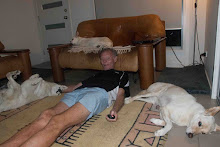When looking at dogs that are related, we need to remember that all dogs are dogs so to some level are all related. Registered pedigree dogs, with few exceptions, are closed groups so are more closely related to each other than to dogs of other pedigree breeds. Village dogs have no such restriction and have a greater genetic diversity and most have lower coefficient of inbreeding (COI) than breeds. Noticeably village dogs, almost without exception, show a small percentage of German Shepherd dog (GSD) DNA. This is probably due to a stable section of DNA that has been continued from ancient times before any of todays breeds were created, starting a mere couple of hundred years ago. Not surprisingly this GSD connection also shows up in pedigree Canaan dogs. (CD)
Kiva's parents were both freeborn dogs, one from Jordan. Both parents were used extensively to breed Canaan dogs that were registered after the 3-generation process recognised before today's DNA tests became widely available.
https://app.embarkvet.com/pet/c7e80576-2e12-4691-8d7a-17d1adfb35f2/relatives
Kiva is also a DNA relative of Zackie, and both are DNA relatives of Miles who was found in a shelter in USA and was dismissed by Canaan people as not possibly a Canaan because they never end up in shelters, does not even look like a Canaan etc. etc. until the breeder came forward and recognised Miles as one of her bred CD's.
https://app.embarkvet.com/pet/b030e766-21b0-4af6-b2fd-12f00d875c62/relatives
Also DNA related to both Zackie and Miles is Lady.
https://app.embarkvet.com/pet/c238e384-66d9-4e15-be00-7b6806f1f92f/relatives
Unless a dog that has not been neutered is permanently kept closed in a kennel it cross breeding is going to occur. No "responsible breeder", can guarantee that will never happen with a dog they have sold. Kaleb is an example of such a mix. Riley, with 26.5% CD is such an example.
https://app.embarkvet.com/pet/5e6fb08f-a7fd-40f7-9932-489333a51ca4/about
Village dogs are not closed groups and regardless of if they are grouped by region Saudi Arabiaor country their DNA profile is flexible simply because they are not a closed group, so DNA profiles depend on what dogs have been tested and it is not possible to test every dog in a group. Village dogs can show up as mixed if a modern breed of dog has been allowed to roam but is less likely to occur in places like Saudi Arabia than is the case with CD's in USA or UK. Why Embark have left out Saudi Arabia from the updated classification of village dog groups I fail to understand. They have tested a dozen 100% pure village dogs from Saudi that I know of and probably more that I don't know.


